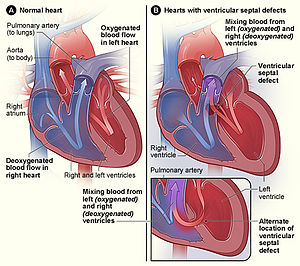先天性心脏病
| 先天性心脏病 | |
|---|---|
 | |
| 左图为正常心脏,右图则显示心室中膈缺损的心脏。心室中膈缺损是最常见的先天性心脏病类性[1]。 | |
| 类型 | 心脏病、先天性障碍、cardiovascular abnormality[*]、genetic cardiac disease[*]、遗传性疾病、rare genetic developmental defect during embryogenesis[*]、疾病 |
| 分类和外部资源 | |
| 医学专科 | 心脏学 |
| ICD-9-CM | 746.9 |
| OMIM | 234750、140500 |
| DiseasesDB | 17017 |
| MedlinePlus | 001114 |
| Orphanet | 88991 |
先天性心脏病(congenital heart defect, CHD)简称先心病,是婴儿出生时就存在的心血管结构和功能的异常[2];其形成是因为胚胎时期心脏和大血管发育异常或发育障碍,以及出生后应退化的组织未退化所造成的心血管局部解剖结构异常。
先心病有其他异名,如:先天性心脏缺陷(congenital heart defect)、先天性心脏异常(congenital heart anomaly)、先天性心血管畸形(congenital cardiovascular malformation/deformity),且根据血流动力学结合病理生理变化,先天性心脏病可分为发绀型或者非发绀型,也可根据有无分流分为三类:无分流类、左至右分流类和右至左分流类。
先心病的征象和症状随心脏问题的种类而不同[3]。症状可能很轻微,也可能危及生命[2]。若有症状,可能会包括呼吸急促、发绀、体重增加缓慢、以及容易疲倦[4]。一般不会有胸痛的症状[4]。大部分的先天性心脏病不会和其他疾病一起出现[3]。心脏缺陷可能会造成其他并发症,包括心脏衰竭[4]。
先天性心脏病的成因大多未知[5]。部分的病例归因于在怀孕时期的感染(如德国麻疹)、使用特定药物或有毒物质(如酒精或烟),而父母亲也和此疾病有关连,如母亲的营养不良或肥胖[3][6]。父母亲其中一方有先天性心脏病也是危险因子[7]。某些基因的状况也会和此心脏疾病有关,如唐氏症、透纳氏症,和马凡氏症候群[3]。先天性心脏病可以分成两类:发绀性心脏病和非发绀性心脏病,是依儿童是否会发绀来分。[2]心脏病的发病位置可以包含心脏的内壁、心脏瓣膜,或是流入心脏或流出心脏的大血管[2]。
先天性心脏病可以透过接种德国麻疹疫苗、含有碘的盐,及添加了叶酸的某些食物制品,来达到部分的预防功效[2]。某些情况下它是不需要被治疗的 [2],其他则可以透过心导管手术或心脏外科手术完成有效的治疗[8]。有时则需要心脏移植[8]。只要有适当的治疗,即便病情再复杂,治疗成果通常良好[2]。
心脏疾病是最常见的先天缺陷[3][9]。在2013年,全球有3430万人罹患此疾病[9]。根据诊查状况,先天性心脏病每千名活产新生儿大约可影响4至75人[3][7]。而大约每千名活产新生儿内有6至19人可能有轻微至严重的病情[7]。先天性心脏病是最主要先天疾病相关的死因[3]。在2013年,先天性心脏病造成了323,000人的死亡,这个数字较1990年的366,000人死亡来的低[10]。

参考文献
[编辑]- ^ Hoffman JI, Kaplan S. The incidence of congenital heart disease. J. Am. Coll. Cardiol. June 2002, 39 (12): 1890–900. PMID 12084585. doi:10.1016/S0735-1097(02)01886-7.
- ^ 2.0 2.1 2.2 2.3 2.4 2.5 2.6 What Are Congenital Heart Defects?. National Heart, Lung, and Blood Institute. July 1, 2011 [10 August 2015]. (原始内容存档于2015-08-13).
- ^ 3.0 3.1 3.2 3.3 3.4 3.5 3.6 Shanthi Mendis; Pekka Puska; Bo Norrving; World Health Organization. Global Atlas on Cardiovascular Disease Prevention and Control (PDF). World Health Organization in collaboration with the World Heart Federation and the World Stroke Organization. 2011: 3, 60 [2016-01-20]. ISBN 978-92-4-156437-3. (原始内容存档 (PDF)于2014-08-17).
- ^ 4.0 4.1 4.2 What Are the Signs and Symptoms of Congenital Heart Defects?. National Heart, Lung, and Blood Institute. July 1, 2011 [10 August 2015]. (原始内容存档于2015-07-27).
- ^ What Causes Congenital Heart Defects?. National,Heart, Lung, and Blood Institute. July 1, 2011 [10 August 2015]. (原始内容存档于2015-07-08).
- ^ Dean, SV; Lassi, ZS; Imam, AM; Bhutta, ZA. Preconception care: nutritional risks and interventions.. Reproductive health. 26 September 2014,. 11 Suppl 3: S3. PMID 25415364. doi:10.1186/1742-4755-11-s3-s3.
- ^ 7.0 7.1 7.2 Milunsky, Aubrey. 1. Genetic Disorders and the Fetus: Diagnosis, Prevention and Treatment. John Wiley & Sons. 2011 [2016-01-20]. ISBN 9781444358216. (原始内容存档于2016-03-05).
- ^ 8.0 8.1 How Are Congenital Heart Defects Treated?. National Heart, Lung, and Blood Institute. July 1, 2011 [10 August 2015]. (原始内容存档于2015-07-27).
- ^ 9.0 9.1 Global Burden of Disease Study 2013, Collaborators. Global, regional, and national incidence, prevalence, and years lived with disability for 301 acute and chronic diseases and injuries in 188 countries, 1990–2013: a systematic analysis for the Global Burden of Disease Study 2013. Lancet (London, England). 7 June 2015. PMID 26063472. doi:10.1016/S0140-6736(15)60692-4.
- ^ GBD 2013 Mortality and Causes of Death, Collaborators. Global, regional, and national age-sex specific all-cause and cause-specific mortality for 240 causes of death, 1990-2013: a systematic analysis for the Global Burden of Disease Study 2013.. Lancet. 17 December 2014, 385: 117–71. PMC 4340604
 . PMID 25530442. doi:10.1016/S0140-6736(14)61682-2.
. PMID 25530442. doi:10.1016/S0140-6736(14)61682-2.
参见
[编辑]- 二尖瓣闭锁不全
- 心房第一中隔第一孔 (心房中隔第一孔/Primary interatrial foramen)
- 心房第一中隔第二孔 (心房中隔第二孔/Foramen secundum)
- 心房第二中隔卵圆孔 (心房中隔卵圆孔/Foramen ovale (heart))
- 弯刀综合征 (Scimitar syndrome/阿拉伯弯刀症候群/肺静脉回流异常(PAPVR))
外部链接
[编辑]- Congenital Heart Disease, Causes and Its Treatment
- 开放目录项目中的“先天性心脏病”
- Cove Point Foundation Congenital Heart Disease websiteArchive.is的存档,存档日期2013-02-18 — comprehensive patient education, including animations of surgeries and interventions
- Congenital Heart Surgeons' Society Data Center(页面存档备份,存于互联网档案馆) — a research organization based at The Hospital for Sick Children, Toronto
- Congenital heart disease information for parents.
- 马偕纪念医院小儿心脏科卫教资讯(页面存档备份,存于互联网档案馆)
- [1] (页面存档备份,存于互联网档案馆)
- [2] (页面存档备份,存于互联网档案馆)
